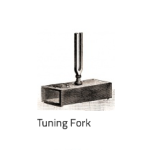Video
Recording the vibrations of tuning forks
Recording the vibrations of tuning forks
This video demonstrates the principle of recording the vibrations of tuning forks.
A small glass sheet is covered in a layer of black carbon, using the fumes of a turpentine lamp. A writing tip is fixed to one of the prongs of the tuning fork (A). A second tuning fork (B) is horizontally fixed on a wooden base. The tuning fork (A) is fixed in a slider that can slide on the base. The blackened glass plate is fixed on one of the prongs of the tuning fork (A). This is vibrated and slowly moves along the tuning fork (B). The experiment is repeated by vibrating the tuning fork (B). When the sheet is removed, the recordings of the vibrations of two tuning forks appear. A new plate is fixed at (B). Both tuning forks are made to vibrate and their combined movement is recorded. On the plate, there appears the trace produced by the interference of the two frequencies of the tuning forks, which are slightly different. The maximum and minimum of the curve correspond to the beats.
© 2015 – 2026 Humboldt-Universität zu Berlin






